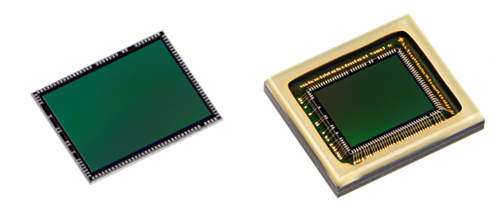Update, Wednesday, November 5, 2025
ST will be holding a webinar on the VB1943, VB5943, VD1943, and VD5943 sensors on Wednesday, November 12. Attendees will learn more about the devices themselves and how they can give them an applicative edge against their competitors. The presenters will go over some of the concepts covered in this blog post, enabling our community to learn more. Speakers will also show how to use those devices to help members of the ST community get started. There will even be a Q&A session to allow anyone to ask questions.
Original publication, October 20, 2025
STMicroelectronics is officially unveiling its newest 5-megapixel image sensor series – comprising the VB1943, VB5943, VD1943, and VD5943 models part of ST BrightSense portfolio – raising the bar for applications such as security, robotics and machine vision. Available in monochrome and RGB-IR versions, these sensors combine global and rolling shutter, advanced 3D-stacked pixel architecture, and on-chip RGB-IR separation to deliver industry-leading performance and versatility. In this article, we delve into the key innovations that position this sensor series as a true market game changer.

Choosing between global and rolling shutter
Global shutter
Very early in the product design phase, engineers must decide whether to adopt a CMOS image sensor with a global shutter or a rolling shutter. Each shutter type relies on specific pixel and readout architectures, which is why, until now, the vast majority of image sensors have only supported one or the other.
As the name suggests, a global shutter captures light over the entire sensor simultaneously, then reads out the information sequentially. This requires adding extra circuitry and in-pixel memory to store temporarily the captured data in memory before streaming it to the processor. Global shutters are ideal for applications requiring precision and uniformity, as they provide immunity to motion and lighting artifacts by capturing the entire scene at once, eliminating distortion caused by movement during exposure.
However, these benefits come with trade-offs: global shutters tend to be slower in readout, less power-efficient, and less sensitive to light due to the added in-pixel circuitry.

Rolling shutter
As the name suggests, a rolling shutter sensor exposes the image sensor one row or a few rows at a time in a sequential, rolling fashion. While each row is exposed, the sensor simultaneously processes the data to gradually build a complete frame. This simpler operation eliminates the need for the additional memory and circuitry required by a global shutter, resulting in lower power consumption and greater pixel sensitivity. Because more of each pixel’s surface area is dedicated to light capture, rolling shutters typically deliver better image quality in low light conditions. For these reasons, rolling shutter CMOS sensors are widely used in most consumer electronics today. However, without intermediate memory to hold the entire frame simultaneously, rolling shutters are prone to distortions and artifacts. Additionally, the illumination must remain active throughout the sequential exposure of all rows, which can increase the overall lighting budget.
The best of both worlds
By offering a dual global and rolling shutter, users gain the advantages of both technologies: artifact-free image capture from the global shutter and exceptional image quality enhanced by on-chip HDR from the rolling shutter. The operating mode can be selected via register settings, allowing seamless switching from frame to frame to alternate between distortion-free global shutter captures and high-dynamic-range rolling shutter images.
While combining these two shutter modes may seem like an obvious improvement, it presents significant architectural challenges that ST has successfully overcome. Traditionally, integrating global shutter functionality into a rolling shutter sensor requires adding complex bottom-layer circuitry, which increased sensor size, cost, and reduced pixel sensitivity. This, in turn, compromised HDR performance and increased noise levels. Leveraging advanced 3D stacking technology—which vertically stacks multiple wafers into a single chip—ST has managed to address these challenges, delivering a sensor that combines the strengths of both shutter types without the usual trade-offs.
Making sensors smarter with 3D stacking
Top wafer
ST designed an original architecture based on two wafers. The top one uses a 65-nm process node and contains both the 2.25 µm pixels and the storage nodes. In a nutshell, we embed capacitors vertically in silicon, thanks to deep trench isolation or CDTI (capacitive deep trench isolation). Hence, instead of placing the capacitors on the side, which would increase the device’s size, we create deep and narrow trenches in the silicon layer to sandwich capacitors between pixels, utilizing full-depth deep trench isolation to prevent crosstalk. Consequently, we can develop larger pixels while also designing an architecture compatible with a global shutter mode.
Bottom wafer
The bottom wafer utilizes a 40-nm process node and contains both digital and analog circuitry. This approach ensures the pixel layer can capture more light, since this logic does not encumber it. It is also the reason why we can offer a resolution of 5 megapixels without having to increase the overall size of the device or its price. Indeed, this dual wafer approach utilizes manufacturing techniques we have developed in our 300-mm European fab. Hence, we can create those two wafers very efficiently, bond them, and offer two shutter modes while remaining competitive compared to a similar 5-megapixel CMOS sensor that offers only a global shutter mode.
Furthermore, 3D stacking technology allows embedding additional circuitry and on-chip processing directly within the sensor, creating smarter image sensors that provide enhanced functionality and performance while offloading the host processor, such as the RGB-IR conversion and smart upscale available in VD1943 and VB1943 RGB-IR variants.
Seamless color and infrared imaging
From monochrome to RGB-IR
The sensor series offers two color variants to address distinct application needs. The VD5943 and VB5943 deliver high-quality monochrome images, ideal for machine learning algorithms and use cases such as in-line product inspection and barcode reading that rely on grayscale imaging.
In contrast, the VD1943 and VB1943 feature a unique pixel structure with classical RGB subpixels plus an additional near-infrared (NIR) subpixel, enhancing performance in both global and rolling shutter modes.
In global shutter model, the near-IR subpixel is exposed longer to capture critical information, enabling the VD1943 and VB1943 to produce near infrared images with accuracy compatible to dedicated monochrome image sensors – offering a single-device solution for applications requiring both color and monochrome imaging such as security and electronic toll collection. However, if a company wants to qualify only one device, they can choose the VD1943 while still enjoying quality monochrome images that will lead to accurate inferences.
In rolling shutter mode, the NIR subpixel plays a crucial role in color accuracy.. Since red pixels are also sensitive to near-infrared wavelengths, this can distort color reproduction. Instead of relying on external IR cut-off filters or complex processing, ST’s sensors use the NIR subpixel data to isolate and subtract the infrared component from other color channels, resulting in more accurate color fidelity, enhanced signal-to-noise ratio, and overall improved image quality.
Automatic color/infrared switching
The RGB-IR variants of STMicroelectronics’ sensor series feature on-chip RGB-IR separation, eliminating the need for external companion chips and significantly simplifying system design. This integration also incorporates built-in demosaicing, reducing software complexity and processing overhead. The sensor supports multiple configurable output formats, including full-resolution 5 MP RGB-NIR 4×4 pixel grouping, native 5 MP RGB Bayer pattern, 1.27 MP NIR subsampling, and 5 MP NIR smart upscale modes, with independent exposure control for each channel. The smart upscale functionality ensures full 5 MP resolution for both color and near-infrared imaging, delivering high-fidelity data streams without compromise.

Additionally, users can easily switch between color and NIR outputs through a single register setting, enabling rapid adaptation to varying application needs. This comprehensive on-chip integration reduces bills of materials, simplifies software development, and enhances overall system flexibility and performance.
Evaluation Kits & Samples
To fully appreciate the capabilities and innovations detailed in this article, evaluation kits and samples are now available.
- Learn more about our RGB-IR models (VD1943 and VB1943)
- Check out the monochrome models (VD5943 and VB5943)
